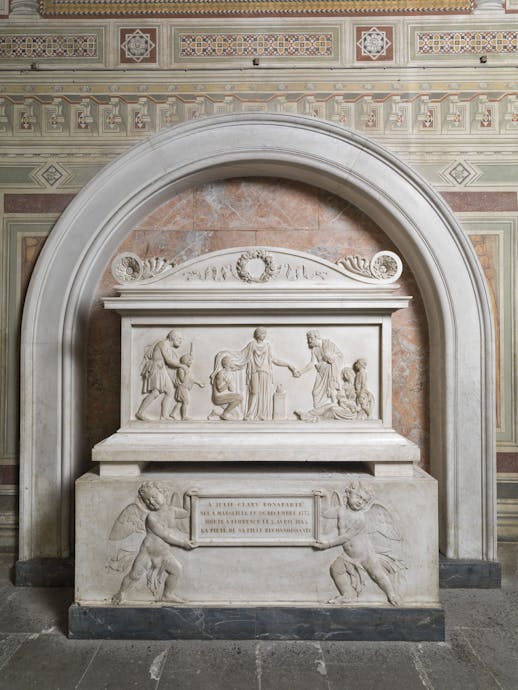
Giugni Bonaparte Chapel
The third chapel in the south transept was founded by the Giugni, one of Florence's oldest families, the roots of whose wealth lay in the wool trade.
The chapel was built during the first phase of the present church's construction (1295–1310) and frescoed with scenes of the martyrdom of the Apostles, to whom the chapel was dedicated. Early sources claim that the cycle was painted by Giotto but scholars today are more cautious because the painter's output was not differentiated from that of his assistants and followers until the 20th century. The frescoes were whitewashed over, probably in the 18th century, and the only surviving part of the original 14th century decoration is the stained-glass window which was moved to the Peruzzi Chapel in the 20th century.
Patronage of the chapel was acquired in 1839 by Joseph Bonaparte, Napoleon's elder brother and former King of Naples and Spain, who instantly set about having it renovated. Giuseppe Bezzuoli's altarpiece depicting the Assumption of the Virgin for the new altar and Lorenzo Bartolini's monumental tomb of the patron's daughter Charlotte Napoléone Bonaparte were both in place by 1840.

Lorenzo Bartolini, Monumental tomb of Charlotte Napoléone Bonaparte, 1840. Basilica of Santa Croce, south transept, Giugni Bonaparte Chapel
This was followed in 1847 by Luigi Pampaloni's tomb of Joseph's wife Julie Clary, while the mortal remains of Joseph himself, who had been buried in the chapel in 1844, were moved by order of Emperor Napoleon III to the Dôme des Invalides in Paris eighteen years later.

Luigi Pampaloni, Monumental tomb of Julie Clary Bonaparte, 1847. Basilica of Santa Croce, south transept, Giugni Bonaparte Chapel
The chapel's present aspect was conferred on it in 1918, when it was reconsecrated to the Sacred Heart of Jesus in memory of those who fell in the Great War. Opera di Santa Croce architect Ezio Cerpi renovated it in the Neo-Gothic style, installing a new stained-glass window with full-figure depictions of St. Francis, St. Bonaventure, St. Elisabeth, St. Clare, St. Louis of Toulouse and St. Louis IX of France. The walls were frescoed with imitation marble panels by Amedeo Benini. The 19th century altar designed by Bartolini was dismantled and Bezzuoli's large altarpiece is now in the Museo dell'Opera, while a Triptych of the Sacred Heart painted by Ricciardo Meacci and carved by Aristide Aloisi was placed on the new altar.